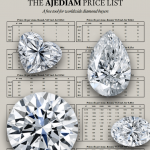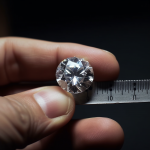Diamond Prices
Read moreThe Star of South Africa Diamond
The Eureka Diamond’s Descendant
The Star of South Africa Diamond has been an important stepping-stone for the rise of South Africa in the diamond mining world. After the Eureka Diamond was unearthed, The diamond industry set its sights on South Africa and it was determined to find out whether or not the country would become the next big player in the diamond world. Thus, the finding of the Star of South Africa fueled the Diamond Rush which further drove the nation’s Mineral Revolution.
If you’d like to learn more about The Star of South Africa Diamond, in this article you will find:

- Discovered in
- 1869
- Country of Origin
- South Africa
- Mine of Origin
- Orange River
- Carat Weight
- Original Rough: 83.50 carats
- Final Cut: 47.69 carats
- Cut Shape
- Pear-shaped, three-sided stellar brilliant cut
- Clarity
- Suspected to be of great clarity with no visible inclusions
- Color
- D-color (colorless)
- Previous Owners
- Griqua Witch Doctor named Swartbooi (or Griqua shepherd boy - discoverer)
- Schalk van Niekerk (buyer)
- Lilienfeld Brothers (buyers)
- Earl of Dudley
- Countess Dudley (wife of the Earl of Dudley)
- Christie's Auction (1974) - Anonymous buyer for private collection
- Current Owner
- Private collector (name undisclosed)
- Estimated Value
- Sold for £11,200 in 1869 (equivalent to approximately £1,418,508.71 in 2021)
- Sold at Christie's Auction (1974) for £225,000 (approximately £2.5 million nowadays)
The Origins of The Star of South Africa Diamond
The Star of South Africa Diamond was discovered in 1869 on the banks of the Orange River by a Griqua Witch Doctor named Swartbooi. In some versions, the legend says it was a Griqua shepherd boy.
The Star of South Africa Diamond is discovered
In any case, because the event took place after the unearthing of the Eureka Diamond, it is fair to say the winds of change were blowing rapidly in South Africa. People who worked in the diamond industry (or wanted to) were pouring into the country, but the locals became more interested as well. Now that everyone knew how much value there could be to ‘shining pebbles’, everyone was looking for them everywhere. Needless to say, amidst the country’s convoluted state, the glimmering stones meant opportunity and socio-economic mobility to those lucky enough to come across them.
One of the discoverers of the Eureka diamond buys the Star of South Africa Diamond
Schalk van Niekerk and John O’Reilly are back at it! If you have read our article on the Eureka Diamond, these two names will probably ring a bell. The two men were responsible for corroborating the Eureka as a real diamond. Throughout history, O’Reilly has often been credited with being the only one who suspected the Eureka to be genuine. However, some scholars believe that van Niekerk also had his suspicions based on the gem’s qualities.
This theory is often supported by van Niekerk’s involvement with the Star of South Africa Diamond. Since the sale of the Eureka, he had become more wealthy and was feverishly looking for more of the precious stones. He was immediately interested when he found out what Swartbooi had unearthed. He bought the rough diamond for an amount of 500 sheep, 10 oxen, and a horse.
Schalk van Niekerk sells the gemstone and the buyers christen it ‘The Star of South Africa’
The acquisition could have meant the end for Schalk van Niekerk and his family; his instincts, however, were correct. He employed the help of John O’Reilly once more. The two had become close since the journey they had already been through with the Eureka Diamond. O’Reilly agreed with van Niekerk’s suspicions that yet another potential fortune was in their reach.
One can imagine the two men’s trust in each other, as they had already found and successfully sold two diamonds by this point. So they went straight to the previous buyer – the Lilienfeld Brothers in Hopetown, who were indeed interested and purchased the Star of South Africa for £11,200 (c. £1,418,508.71 in 2021) on 19 March 1869. The deal made van Niekerk a comfortably wealthy man again. It was then that the Lilienfield Brothers gave the gem its name – The Star of South Africa.
The Cutting of The Star of South Africa Diamond
The Lilienfeld Brothers were established merchants in the diamond buying business and had financial agreements with the prominent Mosenthal family of Port Elizabeth. They bought the Star of South Africa in the rough when it was a rough stone weighing 83.50 carats.
The Star of South Africa Diamond makes its way to the City of Diamonds
They had the diamond sent to England. There are some conflicting opinions on where the diamond was cut. Some claim it was cut in England because it was later sold there. However, most scholars believe the rough crystal was sent to Amsterdam to be cut. Amsterdam’s diamond trade was still flourishing and the Dutch capital was known as the City of Diamonds. The best professionals who would be able to handle the gem would probably be residing there or in nearby Antwerp.
The Star of South Africa Diamond earns its name
The rough stone was cut and polished to a 47.69-carat pear-shaped three-sided stellar brilliant diamond. Later, when it was put up for sale at Christie’s (1974) the diamond had already been set in a jewel. The gemstone was suspended from a detachable pendant set with brilliant-cut diamond collets with round-cut diamond intersections.
The Ownership History of The Star of South Africa Diamond
Swartbooi was the discoverer of The Star of South Africa Diamond. The gemstone then passed through the hands of Schalk van Niekerk and was eventually sold to the Liliendfeld Brothers who had it cut in London. The Brothers worked with Hunt & Roskell, who were renowned jewelers and silversmiths who had the Royal Warrant of Queen Victoria!
The noble Earl of Dudley purchases the Star of South Africa Diamond for his wife
In its polished form, the Star of South Africa Diamond was a sought-after jewel. Not only was it beautiful but it was also extremely clear. This is how it drew the attention of the Earl of Dudley. Hunt & Roskell sold the diamond to the Earl for £25,000 (ca £3 million nowadays). The Earl had bought it as a present for his wife – Countess Dudley. The diamond remained part of the Dudleys’ collection for many years. It even came to be known, unofficially, as the Dudley Diamond.
Lady Dudley passed away in 1921, so scholars assume she sold the diamond before her death. Details about the sale like the amount and the buyer are not available. It did not reappear in the public’s eye until the 1974 Christie’s sale.
An anonymous buyer purchases the Star of South Africa Diamond for their private collection
The Christie’s auction was held on 02.05.1974 in Geneva. The Star of South Africa Diamond was expected to attract a lot of interest. The expected price for it was at least £150,000 (ca. £1,67 million nowadays). The organizers’ expectations, however, were exceeded when the jewel sold for £225,000 (ca. £2.5 million nowadays). It was bought anonymously for a private collection so details about the buyer are unavailable. The diamond remains part of this collection.
The owner has not kept it away from the public though. It was presented at the Diamants exhibition in Muséum national D’histoire Naturelle in Paris in 2001. Subsequently, it also appeared in the Diamanti exhibition in Scuderie del Quirinale in Rome in 2002. Hopefully, the beautiful Star of South Africa Diamond will reappear again soon.
The Technical Characteristics of The Star of South Africa Diamond
The Star of South Africa diamond is a D-color, pear-shaped, three-sided stellar brilliant-cut stone, weighing 47.69 carats. Since it has been a part of private collections for most of its existence, there have not been official studies of the gemstone. This also means there are no clarity grades. Although there are no official clarity grades, the Star of South Africa is suspected to be of great clarity. It has no visible inclusions. The stone was cut down from 83.50 carats.
The Significance of The Star of South Africa Diamond
The Star of South Africa Diamond was amongst the first to be found in the country. What started with wonder when the Eureka Diamond was discovered quickly turned into a feverish search for precious gemstones. It is fair to say the infamous stone was a catalyzer to the Diamond Rush in South Africa. The influx of seekers of buried riches was actively forming South Africa’s future.
The star’s revelation played an important role in the development of the nation’s standing as a geographic location of value for gemological exploration. Without such interest, for example, another infamous South African stone, the Kimberley Diamond, would have arguably never been reached. After such a find, thousands began pouring into the country, starting new businesses and moving the economy forward. South Africa was changed forever.
We hope you enjoyed the read!
If you’d like to read about other famous diamonds like the Orlov, Eureka, or Premier Rose diamonds, you can visit Ajediam’s Famous Diamonds glossary. Or, if you’re feeling inspired, you can browse Ajediam’s premium diamond collections shop.



